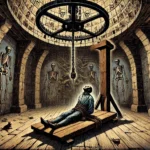The Masque of the Red Death, written by Edgar Allan Poe and published in 1842, is a gothic short story that combines horror with allegory. Set against the backdrop of a terrifying plague, the story explores themes of death, inevitability, and human folly. Poe, a master of macabre tales, uses the narrative to delve into the futility of attempting to escape death, no matter how wealthy or powerful one may be.
Plot Summary
In a distant land ravaged by the Red Death, a plague so horrifying that its mere mention filled the bravest hearts with terror, a wealthy prince named Prospero sought to defy its reach. The Red Death had already claimed countless lives with its gruesome symptoms: sharp pains, sudden dizziness, and bleeding from the pores. The infected were marked by scarlet stains, especially upon the face, and death came swiftly, within half an hour. As the disease ravaged his dominion, Prospero turned away from his suffering people, retreating to one of his remote, fortified abbeys with a thousand of his closest, healthy nobles. There, he believed, they could escape the horror that raged outside their walls.
This abbey, a creation of Prospero’s eccentric mind, was a grand and imposing structure, encircled by tall, iron-barred walls. He commanded that the gates be locked, and once sealed inside, no one would leave, nor would anyone be allowed in. It was his hope that, within these walls, they could ignore the death outside and indulge in a life of pleasure and excess. The prince, known for his love of lavish displays, made sure the abbey was filled with every form of entertainment: musicians, dancers, jesters, and all the finest luxuries one could desire. Here, within their sanctuary, the courtiers turned their backs on the suffering of the world, trying to forget the plague that still claimed lives beyond their sanctuary.
Time passed, and for months, the revelers enjoyed their secluded paradise. But as the pestilence grew more savage in the lands outside, Prospero resolved to throw a grand masquerade ball. This event would be the pinnacle of their hedonistic isolation, a night of fantastical splendor and revelry. The masquerade was held in a suite of seven rooms, each uniquely decorated, each more bizarre than the last. In this labyrinth of chambers, no two were alike. The rooms twisted and turned, their layout as erratic as the mind of the prince who designed them. Each chamber was lit by braziers outside the windows, casting colored light through stained glass that matched the hue of the room’s decor. The first room was draped in blue, the next in purple, followed by green, orange, white, and violet. But it was the final room—the seventh chamber—that stood apart from the rest. Shrouded in black velvet with blood-red windows, this room was avoided by most of the revelers. It radiated a sense of dread, as though death itself lurked within.
In this final room stood a massive ebony clock, its pendulum swinging with a slow, monotonous clang. Every hour, the clock chimed, and each time it did, the merriment in the other rooms would momentarily cease. The music would falter, the dancers would pause, and a nervous quiet would settle over the revelers as the deep, echoing tolls of the clock reverberated through the chambers. The sound had a peculiar effect on the partygoers, reminding them, however fleetingly, of the passage of time—and perhaps, of the doom waiting for them outside the abbey’s walls. But as soon as the chimes stopped, the festivities resumed, and laughter once again filled the air, as if to banish the discomfort the clock had brought.
As the night wore on, the revelers became more engrossed in the extravagant madness of the masquerade. The costumes were wild and grotesque, a blur of vivid colors and strange forms. Prince Prospero, ever the architect of these delights, moved among his guests with an air of bold satisfaction, reveling in the beauty of the spectacle he had created. His courtiers followed his lead, confident in their safety, wrapped in the illusion of invulnerability. But as the clock struck midnight, a new figure appeared among the throng, a figure that no one had noticed before. This stranger was draped in the garments of the grave, his mask resembling a corpse’s stiffened face. More horrifying still, his robes were splattered with blood, mimicking the unmistakable marks of the Red Death.
A murmur spread through the crowd, as revulsion and terror rippled among the guests. Even in a night of such grotesque indulgence, there was something deeply unsettling about this figure. The costume was too real, too close to the horror they had shut out. Prince Prospero’s face darkened with rage at this affront to his ball. Furious that someone would dare to mock him and his court in such a manner, he demanded that the intruder be seized and unmasked, so that the offender might face punishment.
Yet, when the courtiers hesitated, held back by an unnameable dread, the stranger moved steadily through the rooms, untouched and unhindered. He passed from the blue room to the purple, and then to the green, orange, white, and violet, with a deliberate and measured step. As if frozen by fear, none of the guests dared approach him. Prince Prospero, enraged by the inaction of his court, took matters into his own hands. With a drawn dagger, he rushed after the intruder, determined to confront and kill this mockery of the Red Death himself.
The figure led him through the rooms until at last, they reached the black chamber. There, standing before the ebony clock, the figure turned to face the prince. With a single, horrifying cry, Prince Prospero fell dead to the floor, his dagger clattering uselessly beside him. At that moment, the revelers, emboldened by desperation, rushed into the room, determined to overpower the figure. But when they seized the mysterious guest, they found nothing beneath the grave-like garments—nothing but the intangible, unshakable presence of death itself. The Red Death had infiltrated their sanctuary, unnoticed, and now it claimed each of them in turn.
One by one, the revelers fell, dying where they stood, their bodies marked by the scarlet stains of the plague. As the last of them succumbed, the lights in the abbey’s braziers extinguished, and the life of the great ebony clock stopped. Darkness, decay, and death reigned triumphant, and no living soul was left to oppose them
Main Characters
Prince Prospero: The central figure, Prince Prospero, is a wealthy and arrogant ruler who believes he can outwit death. His eccentricity, pride, and indulgence in luxury and pleasure make him a symbol of the elite’s ignorance and hubris. Despite the looming threat of the Red Death, he isolates himself with his courtiers in a castle, thinking they are immune to the outside world’s horrors. His ultimate downfall is driven by his overconfidence.
The Red Death: While not a conventional character, the Red Death itself is an omnipresent force in the story. This deadly plague is personified in the form of a mysterious, ghastly figure that crashes Prince Prospero’s extravagant ball. It represents the inevitability of death, which strikes without warning and cannot be evaded by any means, not even by wealth or isolation.
Theme
Inevitability of Death: The most prominent theme in The Masque of the Red Death is that death is inescapable. No matter how much Prince Prospero and his guests try to avoid it by retreating into their fortress, the Red Death still finds its way in, emphasizing the futility of trying to avoid one’s fate.
Human Folly and Hubris: Prince Prospero’s belief that he can outsmart death by secluding himself and living in luxury is a clear example of human arrogance. His lavish party in the face of a plague sweeping the country reflects a deep sense of denial and the illusion of control over forces beyond human reach.
The Passage of Time: The ebony clock in the black room serves as a constant reminder of time passing and the approach of death. Each chime disrupts the revelers, momentarily reminding them of their mortality, only for them to return to their carefree celebrations until the next toll.
Color Symbolism: The seven rooms, each decorated in a different color, symbolize the stages of life, from birth (blue) to death (black). The progression through the rooms and the black room’s association with death reflect the inevitable journey toward life’s end.
Writing Style and Tone
Poe’s writing style in The Masque of the Red Death is richly descriptive, heavily laden with gothic imagery and dark symbolism. He meticulously builds an eerie atmosphere through his portrayal of the opulent yet claustrophobic setting of Prince Prospero’s abbey. The lavish descriptions of the masquerade ball and the rooms’ ornate decorations create a surreal, dreamlike quality that contrasts sharply with the grotesque imagery of the Red Death. Poe’s use of vivid color imagery, such as the blood-red windows in the final chamber, enhances the sense of foreboding that permeates the narrative.
The tone of the story is dark, ominous, and fatalistic. Poe crafts an atmosphere of mounting tension as the inevitable confrontation with the Red Death approaches. The tone shifts between moments of grotesque splendor and sheer horror, reflecting the dissonance between the revelers’ superficial gaiety and the grim reality they are trying to escape. The final scene, where the Red Death makes its presence known, underscores the inescapable and merciless nature of death, leaving the reader with a chilling sense of hopelessness.
We hope this summary has sparked your interest and would appreciate you following Celsius 233 on social media:
There’s a treasure trove of other fascinating book summaries waiting for you. Check out our collection of stories that inspire, thrill, and provoke thought, just like this one by checking out the Book Shelf or the Library
Remember, while our summaries capture the essence, they can never replace the full experience of reading the book. If this summary intrigued you, consider diving into the complete story – buy the book and immerse yourself in the author’s original work.
If you want to request a book summary, click here.
When Saurabh is not working/watching football/reading books/traveling, you can reach him via Twitter/X, LinkedIn, or Threads
Restart reading!








